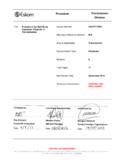Transcription of Paper’s Information - Essay Mall
1 1 paper s Information Topic: Compare and Contrast: Theories of Management paper Type: Essay Word Count: 2000 words Pages: 8pages Referencing Style: APA Style Education Level: Graduate 2 Running Head: Compare and Contrast: Theories of Management Compare and Contrast: Theories of Management [Writer s Name] [Institute Name] 3 Compare and Contrast: Theories of Management Introduction Management, in general understanding, is the art and science of getting things to be done, generally by others (American Society of Mechanical Engineers). It is the way of organising the things and to direct the duties of people in the context of their jobs (Mullins, 2011). For instance, an army is just a group of people until it is organised. In organisations, people are managed in the context of their jobs because all the people have different abilities (Thompson, and McHugh, 2009). Precisely, there is no consensus regarding a single definition of management at all levels because different scholars from different disciplines have defined management with their own perspectives.
2 Discussion These definitions entail the concept that management is an essential component. It is an activity, process, and function in an organisation. In order to practice a successful management, there is a need of theoretical support. Theories of management describe that how people can be more productive and organised to perform certain work (Edward, 1979). Precisely, management theories help people to organise to attain common goals. Established management theories deal with different dynamics of management in an organisation and provide valuable insights for current business practices (Handel, 2003). For instance, classical management theorists provided scientific view point to explain the best way of doing things and to practice management theories. Theoretical support to the subject of management provides insight to managerial activities like organisation, evaluation, planning, and control (Watson, 2012). In short, 4 management practices need the support of theories to determine several functions and organisational needs.
3 In following piece of paper , a compare and contrast study of the theories of management has been described. Theories of management include classical theory of management, human relations theory, systems theory, contingency theory, and labour process theory. Compare and contrast has been done between the different features of these theories with the support of established literature. Classical theory of management was originally developed by Henry Fayol (1841-1925) who is also known as father of modern management. This theory primarily describes the best way of function by workers. In the beginning of twentieth century, its use within organisation was widespread. It salient approaches include Hierarchical structure, division of labour, monetary incentive, and autocratic leadership. Hierarchical Structure: Explaining the hierarchical structure, Fayol noted that organisations hierarchy should be divided into three management levels with distinct roles and responsibilities. At the top level, there should be board of directors, middle level is the body of supervisors considering individual departmental goals, and lower level management over-see daily activities including with the employment issues (Mullins, 2011).
4 Division of Labour: This feature of classical management theory is considered as most advantageous. According to this approach of Fayol, projects should be divided into smaller tasks and these tasks are assigned to employees with clear description. Tasks should be assigned considering the ability and expertise of employees (Edward, 1979). It 5 enhances the productivity and growth of employees and increases the chances of project success. Monetary Incentive: According to this approach, employees should be motivated by monetary rewards. It enhances the dedication and production of employees. Autocratic Leadership: Approach of autocratic leadership sits at the heart of classical management theory which is criticized by many researchers in current century (Handel, 2003). In that approach, it is stated that single leader should hold all the decision-making power and decisions should be delivered top to bottom. Classical management theory is still applicable in many organisations and evidenced practice.
5 Particularly small businesses follow autocratic approach and division of labour to carry out their work. For instance, organisational structure of Wichita State University Libraries is the example body implementing classical theory (Blackburn, 2007). On the other hand, Human Relations theory appears to be entirely in contrast to classical theory of management. It draws its basic arguments upon employee-cantered approach. Emerged originally in 1930s, human relations approach is considered as response of capitalist brutality where workers are of mere importance to organisations (Buchanan, and Huczynski, 2010). Human relations approach primarily concentrates its arguments upon three basic principles: Decentralization: This principle opposes feature of Hierarchy of classical theory of management and emphasize upon coordination between workers and executives through formal and informal channels of communication (Handel, 2003). Human relation approach criticizes presence of any kind of hierarchy within organisation (Thompson, and McHugh, 2009).
6 6 Participatory Decision-making: Human relations theory assumes that employees are capable enough to take their decisions therefore, management should involve them in the matters of decision-making relating to their own as well other matters of organisation (Watson, 2012). Development of Self-motivated Employees: Inspired with autonomy of decision-making, according to the approach of human relations theory, employees have the ability to set their own tasks and to decide their level of achievement. Therefore, managers only need to reward their self-motivation including with the development of increased effective communication between managers and employees (Ritzer, 1993). Effectiveness and practice of human relation theory is highly questionable in current business environment. However, some HR practices have embraced the aspects of human relations theory with the combination of other effective theories. For example, Tavistock Institute and the Research Centre for Group Dynamics at MIT practice human relations theory (Edward, 1979).
7 At the next part, Systems theory provides a holistic view of the parts of an organisation. The focus of systems theory is upon the arrangement of and relations between the parts that connect the other parts into a whole (Thompson, 1989). The idea that underlies the approach of systems theory stated that the behaviour of the whole part is distinct to the behaviour of its individual parts (Ritzer, 1993). Therefore, in order to be successful for an organisation, individual parts must work together in harmony (Thompson, and McHugh, 2009). Furthermore, in organisational context, systems theory is a way of thinking and analyzing about organisation. Systems theory emphasized that success of an organisation depends upon the synergy, coordination, and interdependence between different subsystems. Systems school of thought became influential in 1960s as a way of thinking which will help managers to relate different 7 specialists and parts of company to each other and with environmental factors (Pugh, 2007).
8 Systems school of thought pays equal emphasis upon organisation as whole, and its interaction with environment in order to attain equilibrium (Edward, 1979). Practicing organisation of systems theory includes family structures and administrative structures at organisation level. Researchers suggest that despite of criticism to systems theory, it provided basis for contingency school of management. Contingency theory is an integral part of systems theory, thus, it holds a comparison between both theories. It puts forth the idea that internal subsystems of an organisation form an ideal structure of a successful organisation. In return, organisational structure plays a crucial role in companies' relationships with its employees (Pugh, 2007). Contingency theory is particularly considered as relevant to employee effectiveness with elation to the role of leader. There is no significant relationship between the inherent structures of different organisations except that the structures of different organisations depend on their owners, employees and managers (Pugh, 1990).
9 Contingency theory suggested that a flatter organisational structure in which there is less supervision is likely to increase a company's relationship with its employees and help to develop highly creative roles. Contingency theory believed that there is no single better way to increase the efficiency of an organisation. External and internal factors actually determine the right course of action at a given situation (Fiedler, 1967). Fiedler, originator of contingency management theory, stated that a correlation exists between the traits of a leader and his/her effectiveness (65). Fiedler emphasized that leaders should change their respective traits according to the change situation (62). In short, contingency theory, originally developed by Fiedler (1967), believed that there is no single way to organise the people and to tackle organisational matter, but the attitudes and behaviours are 8 contingent to changed situations. The practicing organisations, in current century, are various.
10 In fact, each organisation thinking strategically tries to evolve and accommodate in current challenging situations. Labour Process Theory, originally crafted by Harry Braverman (1974), focused upon skill as the key component. Original arguments presented by Braverman are distinguished as Marxist views. According to Harry Braverman (1974), two identified skills of labour: complexity and autonomy reduced or even exploited by capitalist firms. Braverman argued that within capitalist organisations, workers or labour are forced to servitude. These capitalist interests eventually lead to reutilisation and deskilling of labour (Buchanan, and Huczynski, 2010). Through the inclination of managers and executives towards higher productivity and lower production cost, managers gradually deskill the existing labour. Deskilled labour force is available easily and easy to treat because they lack the capability of direct engagement with production process. Adler (2007) suggest that Labour Process Theory follows the line of Marxism but focuses only one side of Marx theory that is why most of the arguments of Labour Process theory are contestable (45).






